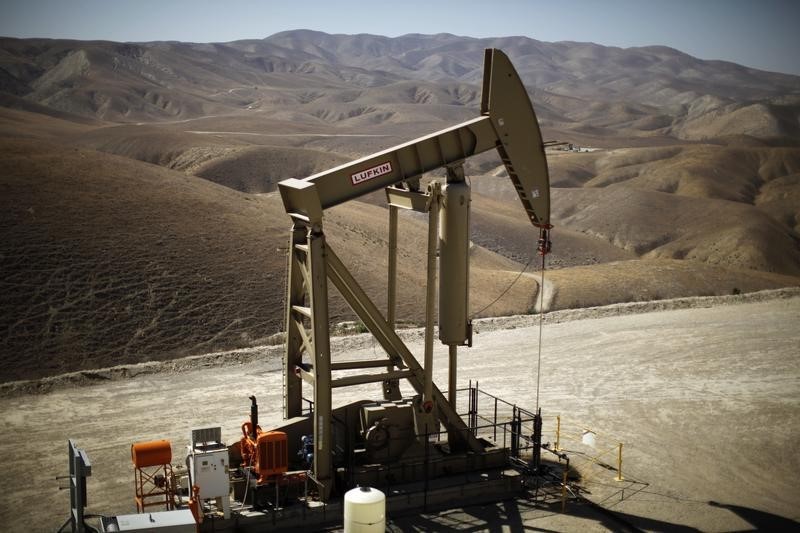By Anna Driver and Terry Wade
HOUSTON (Reuters) - Stagnating rig productivity shows U.S. shale oil producers are running out of tricks to pump more with less in the face of crashing prices and points to a slide in output that should help rebalance global markets.
Over the 16 months of the crude price rout, production from new wells drilled by each rig has risen about 30 percent as companies refined their techniques, idled slower rigs and shifted crews and high-speed rigs to "sweet spots" with the most oil.
Such "high-grading" helped shale oil firms push U.S. output to the loftiest levels in decades even as oil tumbled by half to less than $50 a barrel and firms slashed rig fleets by 60 percent.
But recent government and private data show output per rig is now flatlining as the industry reaches the limits of what existing tools, technology and strategies can accomplish.
"We believe that the majority of the uplift from high-grading is beginning to wane," said Ted Harper, fund manager and senior research analyst at Frost Investment Advisors in Houston. "As a result, we expect North American production volumes to post accelerating declines through year-end."
Drillinginfo, a consultancy with proprietary data, told Reuters well productivity has fallen or stabilized in the top three U.S. shale fields - the Permian Basin and Eagle Ford of Texas and the Bakken of North Dakota – since July or August.
The U.S. Energy Information Administration, whose benchmark drilling productivity index is based in part on Drillinginfo data, forecasts next month's new oil production per rig in U.S. shale fields to stay at October levels, which it estimates at 465 barrels per day (bpd).
The big challenge of shale oil work is that well output drops off quickly - often more than 70 percent in the first year alone. So producers need to keep squeezing more oil out of new wells drilled by the currently deployed rig fleet just to offset steep declines in what existing wells produce.
OLD WELL DRAG
If that is no longer possible and firms remain reluctant to add rigs because of low crude prices and an uncertain outlook, overall production is set to sink. (Graphic: http://link.reuters.com/jem85w)
Chip Davis, managing partner at energy venture capital firm Houston Ventures, says the downward pull of declining output from older wells is getting stronger.
In the Eagle Ford, production from so-called legacy wells fell by 145,485 bpd last month, a drop that was 23 times larger than the 6,293 bpd lost in September of 2010, before the fracking boom brought thousands more wells online.
"The boulder that is decline is much bigger in size and rolling much faster than before," Davis said. "We've got very few rigs to buttress the rate of decline."
That growing drag suggests the fall in U.S. output could be sharper than a 10 percent drop the EIA sees between a peak of 9.6 million bpd in April and next August, when it expects production to bottom at 8.66 million bpd before starting to recover.
Producers' coping strategies with the worst cash crunch in years could be also hurting productivity of new wells.
To save money, many have started drilling shorter and cheaper vertical wells. They have also cut back in some cases on the size of multi-million dollar hydraulic fracturing jobs for long horizontal wells. Both factors can hurt the average amount of oil being added by new wells.
Analysts say it is hard to predict how much U.S. output will fall and whether it will undershoot official forecasts because lower production could lift prices and that in turn might prompt producers to redeploy idle rigs to pump more.
But for now, most companies are budgeting less next year for new drilling work and the U.S. rig count has tumbled to 595, according to Baker Hughes.
Analysts at Bernstein Research have said that productivity gains so far in this downturn have come from improved efficiency rather than fundamental leaps in technology.
Yet such advances, which are hard to predict, would be necessary to boost productivity again because analysts say shale firms seem to have fully exploited techniques such as drilling multiple wells from one location, drilling longer horizontally, and more intensive fracturing along a well bore.
Initial production rates for new wells in major oil basins also appear to be slowing, Bernstein analysts said, citing their analysis of peak rates dating back to 2009.

"Shale efficiencies will be unable to overcome rig count collapse, leading to a roll in production which is bullish for oil price," they said.